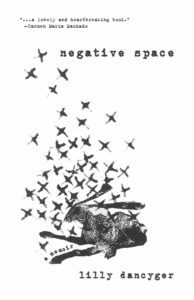
The alchemy of memoir transforms pain into story. Any writer knows that when something hurts, the ache dissolves only under scrutiny. Lean closer, analyzing the details, and after a while, the heartbreak that swallowed them in its maw begins to make sense again. It is linear. It has a beginning, a middle, and an end. The monster, tamed, is banished—soothed, defanged.
This is the magic that Lilly Dancyger performs in her debut memoir, Negative Space. The book meticulously examines the raw, nervy exit wounds her artist father created when he died in 2000. What begins as an unimaginable loss is transmuted into an unforgettable story about love, artistic influence, addiction, and legacy. From Joe Schactman’s impact on the New York gallery scene to his enduring influence on his wildly talented daughter, Negative Space is an emotional archive of an unbearable loss and the proof—and detritus—of the value of love.
A sculptor, wild man, and heroin user, Joe Schactman was a force in life. After his untimely death at the age of forty-three, his life and its meaning was an irresistible riddle for Dancyger. His was the voice in her ear, the influence on her earliest attempts at writing, and the invisible hand that seemed to guide her through the streets of the East Village. “My father probably spent time there,” Dancyger writes. “I wondered if he sat in the same corner of the backyard as I did; if he took classes there or showed work there or just hung out and found his people there, like I had when we first moved back. I wondered if that’s why I was so drawn to that place, a trace of him there, a frequency that my animal-self recognized as home, like salmon swimming toward the place of their birth.”
The rich layers of the past—Dancyger’s, Schactman’s, New York’s—are inextricable. Dancyger pivots nimbly through the convergence of these multiple, vivid histories. A bus transfer in a battered book might lead to a memory of her father’s studio. The pressed-tight crush of a gallery’s opening night recalls a mosh pit at a punk club. This isn’t free association: it’s collage. The deliberate arrangement of the facts and near-facts and maybe-fictions of Dancyger’s story, which seem random or incidental at first, quickly take on a powerful pattern that underlies the memoir. Just as Dancyger senses her father’s presence in the Village, we begin to see him everywhere, too. The rusty bottle caps on the sidewalk. A smear of ruby-glitter nail polish. The stink of fortified wine. The book is crude at times, using outdated terms for opioid users; Dancyger’s memories of her own hard-drinking teenage years are bluntly expressed. From the homemade miniskirts to her mother’s inexplicable suicide attempt after years of recovery, it’s all here, as provocative and stark as one of Schactman’s sculptures.
For all its analysis of the past, Dancyger’s perspective never veers into the schmaltzy side of nostalgia. She writes, “I had a happy childhood, and my parents were junkies. Both of these things are true.” Schactman is not a heroic figure, nor a golden idol. Although Dancyger often imagines him as a lattice, a guide, and a muse, she is also unsparing in her judgment. Her father was mortal, and the mess he left behind him—including a ruined relationship with Dancyger’s mother—is packed with clues about the man under the myth. The genre of memoir is cluttered with gimmicky writing, trauma porn, and solipsistic reminiscences. Mercifully, Negative Space evades these pitfalls without avoiding the sweet stuff, too. The dead can so easily become legends, especially when we love them, especially when they were storytellers themselves, especially when they left us without warning. Dancyger resists this, and although her love for her subject comes through clearly, the story is delivered with the sharp-eyed honesty of a writer who looks at her history without flinching.
“A kind of snarling womanhood” prowls through Negative Space, and Dancyger delights in confounding the musts and shoulds foisted on women. She dances in pointe shoes on the filthy waterfront. She reads her way through a self-assigned syllabus that would choke a PhD student. She sees heroin addiction for what it is, both insidious and wrongly glamorized as the privilege of the talented. Most of all, she spears the paradox of her father: “somehow I could hold these two images in my mind at once: the brutish, demanding husband who compounded his young wife’s sexual trauma; and my father, endless source of art supplies and projects, who used to wink at me with conspiratorial glee.” The frame expands. The structure collapses. The pieces are still speaking.
To call Negative Space a “debut” feels unfair, as Dancyger is a seasoned writer and editor who curated the anthology Burn It Down: Women Writing About Anger (Seal Press, 2019). However, the book is a significant first. Representing decades of work, the book includes lines from Dancyger’s father’s journals and notebooks, images of his sculptures and other artwork, and photos from Dancyger’s own collection. Yet this isn’t a monument to a lost or underappreciated visionary. It is a clarion call that crosses coasts, generations, and forms. The sheer scope of the project is a testament to two ideas: one, that paying attention is the purest form of love, and two, that art is inextricably linked to the essence of the artist. Look, and look again, and forget looking away.




